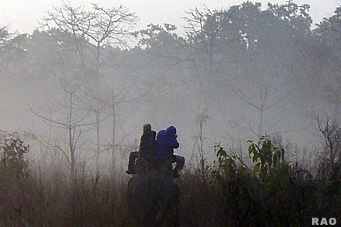 |
Nepal National Parks Chitwan |
|
 |
Nepal National Parks Chitwan |
|
|
 |
|
Protected
Areas and World Heritage: Chitwan National Park
|
Altitude
in Chitwan ranges from 150m to 815m on the Churia Range.
 |
|
Chitwan National Parkis situated in a river valley basin or dun, along the flood plains of the Rapti,
Reu and Narayani rivers. The Someswar and the Dauney hills form thesouthern
catchment and both drain into the Narayani.
The Churia Hills bisect the
park, their northern face falling within the catchment of the Rapti and
southern side forming the catchment of the Reu.
|
|
The
Rapti is bounded by the Mahabharat Range on the north.
Both the Rapti and
Reu flow westwards and drain into the Narayani, which meanders southwards
for about 25km through a narrow gorge between the Someswar and Dauney hills
until it reaches the Nepal-India border. Here it is dammed near Tribenighat.
The
Narayani is also called the Gandaki and is the third largest river in Nepal.
It originates in the high Himalaya and, after joining the Ganges in India,
drains into the Bay of Bengal. The Churia, Someswar and Dauney hills constitute
part of the Siwaliks which are characterised by outwash deposits carried
from the north.
Conditions
are subtropical with a summer monsoon from mid-June to late-September,
and a relatively dry winter. Mean annual rainfall is 2,400mm with about
90% falling in the monsoon from June to September. Monsoon rains cause
dramatic floods and changes in the character and courses of rivers. Temperatures
are highest (maximum 38°C) during this season and drop to a minimum
of 6°C in the post-monsoon period (October to January), when dry
northerly winds from the Himalaya and Tibetan Plateau are prevalent.
he
climax vegetation of the Inner Terai is sal Shorea robusta forest, which
covers some 70% of the park. However, floods, fires and riverine erosion
combine to make a continually changing mosaic of grasslands and riverine
forests in various stages of succession.
Over
40 species of mammals have been recorded. Prior to its re-introduction
to Royal Bardia National Park in 1986, the park contained the last Nepalese
population of the Indian rhinoceros Rhinoceros unicornis. Tiger is present.
Leopard is widespread and other threatened mammal species include wild
dog Cuon alpinus, sloth bear , Ganges river dolphin and gaur.
A
larger number of bird species has been recorded in Chitwan (489 in total)
than in any other protected area in Nepal. This is attributed to the park's
wide range of habitat types and location within the tropical lowlands of
Central Nepal where eastern and western species overlap in their distributions.
There are ten breeding species for which Nepal may hold internationally
significant populations including Bengal florican and rufous-necked laughing-thrush.
It is the only locality in the country for striped buttonquail , bristled
grass warbler and slender-billed babbler. Chitwan is very important for
wintering birds (about 160 in total), both winter visitors from outside
Nepal and many altitudinal migrants which descend to the lowlands outside
the breeding season, as well as a valuable staging point for numerous passage
migrant species.
Some
19 species of snake occur in the park including king cobra , green pit
viper, common krai and Indian python. Other notable reptiles are mugger,
gharial, Indian starred tortoise and monitor lizards.
top
| Information
on Nepal's Himalayas |
 |
| Links |
 |
 |
 |
External
link |
 |
UNESCO World
Heritage
|
NEPAL
|
World
Tour - 360°
Views
|
| Kathmandu
Valley, Lumbini, Khumbu-Everest, Chitwan |
|
|







